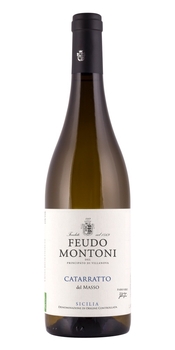Feudo Montoni, Sicilia DOC, Catarratto Masso 2018 (Wilson Daniels, $22) and
Tenuta Regaleali 2018 Sicilia DOC Catarratto “Antisa” ($20): One lesson that many of us have learned from our protracted confinement and conscribed isolation during the COVID-19 pandemic is the wisdom of surrendering control and accepting whatever comes our way. When my school, International Wine Center, conducted a seminar on Sicilian wines for its advanced students, I took that as an opportunity to explore for myself what’s happening with Sicily’s wines these days. Although I consider myself an Italian wine specialist, I have always favored the wines of the North and, apart from Etna, have failed to do justice to Sicily and its wines.
The serendipity paid off. I discovered Feudo Montoni, a brand in the national portfolio of the fine importer, Wilson Daniels. Fabio Sireci, a family owner of

the winery, was one of the speakers in our webinar, along with his wife and colleague Melissa Muller and Salvino Benanti of the Benanti winery on Mt. Etna.
The seminar involved discussion only, but to exploit the learning opportunity, I gathered six Sicilian wines and tasted them that evening. Although Feudo Montoni specializes in Nero d’Avola —Sicily’s most prominent red grape —the one Feudo Montoni wine I could find in my Harlem neighborhood on short notice was the 2018 Catarratto, from Sicily’s most prominent white grape. I also found three Sicilian reds and, in my cellar, a Catarratto called Antisa from Tasca d‘Almerita’s Regaleali estate, and a Grillo called Cavallo delle Fate, also from the same Regaleali property in central Sicily.
The Feudo Montoni estate is “an island within the island of Sicily,” Fabio explained, because viticulturally speaking, it is in the middle of nowhere. It’s in central Sicily, an isolated piece of green perched above fields of golden wheat. (The only other property occupying a similarly isolated situation within central Sicily is Tasca’s Regaleali estate.) Nevertheless, Fabio and Salvino Benanti from far-flung Etna in western Sicily found plenty of common ground to discuss: high elevations that promote freshness atypical for Sicily’s wines, plenty of sunshine, breezes and winds that ward off disease, significant diurnal shifts in temperature, and mineral-rich infertile soils. Both winemakers repeatedly invoked freshness, lower alcohol, elegance and finesse as descriptors for their wines.
I will leave a discussion of Etna for another day, and focus now on Feudo Montoni. That estate encompasses 90 acres of organically farmed vineyards. Catarratto occupies higher elevation vineyards at almost 2300 feet above sea level; the red Nero d’Avola grows much lower, at about 985 feet elevation, which is still high for this grape. These high elevations promote full ripeness and flavor development due to significant sunshine and yet they result in fresh and vibrant wines due to cool night temperatures and the high acidity associated with them.
Catarratto is a somewhat maligned grape because it is so common in Sicily’s recent history, when it has is often been encouraged to produce the high yields required by large wineries and co-ops. But some strains of the grape are much finer than others, and in any case more conservative crop levels can produce finer wines. Both Catarrattos that I sampled — the Regaleali and the Feudo Montoni —were impressive, although different in style.
Regaleali’s 2018 Antisa Catarratto, from grapes cultivated at more than 2900 feet above sea level, is a fully dry, full-bodied, unoaked white wine with fresh, minerally-and-citrus aromatics, noticeable flavor concentration and marked acidity within its substantial, oily-like texture. When first poured, the wine showed visible CO2 in the glass; reopening it the next day, I heard a “pop” as the bottle released the CO2 that was trapped there overnight. Winemakers can retain carbon dioxide in their wines for freshness and to create an impression of heightened acidity, but I sensed no trickery here; while the wine has a slight CO2 prickle on my tongue, that effect works beautifully within the wine’s total taste. The juice fermented in stainless steel tanks, and the wine did not undergo malolactic conversion.
Feudo Montoni’s 2018 Catarratto Masso is deeper in color, fuller bodied and richer in texture — a very different expression of Catarratto. Masso is the name of the area where the 55-year-old bush vines grow in iron-rich, rocky and sandy soil. Fabio ferments their juice in cement tanks and retains the grape skins for 25 percent of the fermentation; the presence of he skins alone accounts for a good deal of the wine’s style, starting with its deeper color. He also holds the wine on its lees, with stirring, in cement for six months after fermentation, a process that enhances the weight and texture of a white wine.
Feudo Montoni 2018 Catarratto Masso is a dry, full-bodied, richly-textured white with real character. Its aromas and flavors are complex, ranging from earthy/ salty minerality to ripe lemons and pink grapefruit, to bay leaf, mint, pine and dried roses. In your mouth, the overall impression is richness — richness of weight, richness of creamy texture, richness of flavor — and smoothness. The secret weapon that keeps this richness from being excessive is the wine’s perfectly attuned acidity. The result is a wine that feels complete: rich yet well-knit within and even lively when you shift your focus to the internal workings of the acidity. Quite an accomplishment.
My lesson—humbly learned — is a reminder not to paint the wines of Sicily with broad brush strokes of over-ripeness and heaviness. I knew that the wines of Etna were an exception and I realized that other exceptions existed, but now I know where to find them.
Feudo Montoni 2018 Catarratto Masso, 92 Points
Tenuta Regaleali 2018 Antisa Catarratto, 90 Points